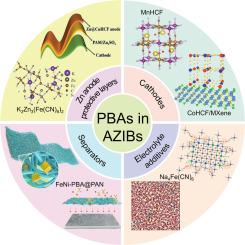水溶液锌离子电池中的“一切”都可能是普鲁士蓝类似物:从阴极材料到电解质添加剂的应用
IF 20.2
1区 材料科学
Q1 CHEMISTRY, PHYSICAL
引用次数: 0
摘要
由于其固有的成本效益、更高的操作安全性和环保特性,水性锌离子电池(azib)在大规模储能应用中显示出巨大的潜力。普鲁士蓝类似物(PBAs)由于其独特的3D开放框架结构和优越的储能能力而成为有前途的阴极候选者。但在实际应用中,多氯联苯仍面临电导率差、过渡金属(TM)离子溶解、结晶水影响等问题。针对这些挑战,本文从离子掺杂、结构工程、复合材料和电解质优化等方面综述了不同金属基PBAs的晶体结构、储能机制和改性策略,以有效提高PBAs的电化学性能。此外,本文还系统总结了PBAs在azib中的多功能应用场景,包括作为正极材料、锌阳极保护层、功能隔膜和电解质添加剂等方面的创新研究进展。最后,讨论了PBAs材料在azib中的实际应用挑战、未来发展和应用前景。本文旨在为azib的进一步开发提供指导和帮助。本文章由计算机程序翻译,如有差异,请以英文原文为准。


Everything in aqueous zinc-ion batteries may be Prussian blue analogues: From cathode materials to electrolyte additives applications
Aqueous zinc-ion batteries (AZIBs) have shown great potential in large-scale storage applications, owing to their inherent cost-effectiveness, higher operational safety, and eco-friendly characteristics. Prussian blue analogues (PBAs) have emerged as promising cathode candidates on account of their distinctive 3D open framework structure and superior energy storage capacity. However, PBAs still face problems such as poor conductivity, dissolution of transition metal (TM) ions, and the effect of crystal water in practical applications. To address these challenges, this article reviews the crystal structures, energy storage mechanisms and modification strategies of different metal-based PBAs in detail, covering ions doping, structural engineering, composite materials and electrolyte optimization to effectively enhance the electrochemical performance of PBAs. In addition, this review systematically summarizes the multi-functional application scenarios of PBAs in AZIBs, including innovative research progress as cathode materials, Zn anode protective layers, functional separators and electrolyte additives. Finally, the practical application challenges, future development and application prospects of PBAs materials in AZIBs are discussed. This review aims to provide guidance and assistance for the further development of AZIBs.
求助全文
通过发布文献求助,成功后即可免费获取论文全文。
去求助
来源期刊

Energy Storage Materials
Materials Science-General Materials Science
CiteScore
33.00
自引率
5.90%
发文量
652
审稿时长
27 days
期刊介绍:
Energy Storage Materials is a global interdisciplinary journal dedicated to sharing scientific and technological advancements in materials and devices for advanced energy storage and related energy conversion, such as in metal-O2 batteries. The journal features comprehensive research articles, including full papers and short communications, as well as authoritative feature articles and reviews by leading experts in the field.
Energy Storage Materials covers a wide range of topics, including the synthesis, fabrication, structure, properties, performance, and technological applications of energy storage materials. Additionally, the journal explores strategies, policies, and developments in the field of energy storage materials and devices for sustainable energy.
Published papers are selected based on their scientific and technological significance, their ability to provide valuable new knowledge, and their relevance to the international research community.
 求助内容:
求助内容: 应助结果提醒方式:
应助结果提醒方式:


